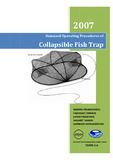Standard Operating Procedures of Collapsible Fish Trap
Share
Abstract
In early times, flowing water caused by tidal movement and changes in river and lake levels were probably used to trap fish behind rudimentary barriers, often made from sticks and stones. It is likely that early humans found that fish catches could be improves by driving fish in to these barriers. They would have found that catches from these barriers decreased over time, as fish became accustomed to them, and would have had to move the traps to fresh areas where more fish could be caught. It would have been hard work to construct new traps, either by moving stones from the old trap or finding new ones. Primitive fishers probably tried making barriers from lighter, more readily available material such as tree branches, brunch and vines. This led to the fishers inventing lighter, movable traps made from brush and nets made from vines which they could carry with them when they moved to new areas. They may even tried bigger, more complicated
corral-type fish traps in lake, rivers and coastal waters.


